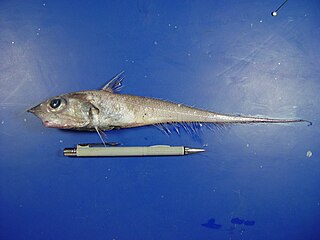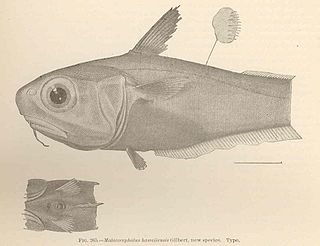
Grenadiers or rattails are generally large, brown to black gadiform marine fish of the subfamily Macrourinae, the largest subfamily of the family Macrouridae. Found at great depths from the Arctic to Antarctic, members of this subfamily are amongst the most abundant of the deep-sea fish.

Coryphaenoides is a genus of rattails which is found in all oceans of the world. They are found in deep waters and C. yaquinae, recorded to 7,012 m (23,005 ft), is the only member in the family known from the hadal zone.

Gadomus is a genus of rattails in the family Bathygadidae.

Lucigadus is a genus of rattails.

Macrourus is a small benthopelagic genus of rattails from the family Macrouridae.

Nezumia is a genus of rattails. The generic name derives from the Japanese 鼠 (nezumi), meaning "mouse".
Coelorinchus asteroides is a species of rattail. This is a deep-water fish found in the waters around Taiwan and southern Japan.
The unicorn grenadier is a species of rattail. This fish is found at depths of up to 600 metres (2,000 ft) in the waters around northern Taiwan, southern Japan and the East China Sea.

Hymenocephalus is a genus of rattails.

Kumba is a genus of rattails.

Ventrifossa is a genus of rattails in the family Macrouridae.
Kuronezumia is a genus of rattails.

Malacocephalus is a genus of rattails.
Mataeocephalus is a genus of rattails.
Mesovagus is a genus of rattails found in Indian and Pacific Ocean.
Pseudonezumia is a genus of rattails. The generic name means "false Nezumia".
Spicomacrurus is a genus of rattails.

Trachonurus is a genus of rattails.

Trachyrincinae is a subfamily of the family Macrouridae, also known as rattails. The subfamily contains two genera found in Atlantic, Indian and Pacific Ocean. These species lives in deep-water. These fishes have a long, narrow and sharply pointed snout. The chin barbel is present.

Coelorinchus caribbaeus, the blackfin grenadier, is a member of the family Macrouridae. It is a marine benthopelagic rattail. It has a wide range in the western tropical Atlantic. It lives in depths of 200 meters to 700 meters.













